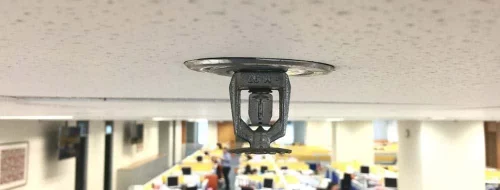If you are the owner of a commercial building, protecting your property from fire damage is a number one priority. An automatic sprinkler system is a great safeguard against fires. What happens to the standing water that’s leftover after the flames are extinguished?
While a sprinkler system saves millions of dollars in tax deductions, code compliance, and insurance savings every year, it cannot compare to the issues and time spent handling the repairs from dealing with water damage.
Here’s what you need to know about automatic sprinkler systems that can provide more insight into how to handle the water after the fire.
Sprinkler Systems Biggest Myth
When a sprinkler system kicks in to stop the spread of a fire, it will not start and spray water in all areas of the building. The sprinkler’s job is to prevent the fire from spreading and causing more damage to unaffected areas. This means the sprinkler system is triggered when the fire is in it’s “flashover stage”, when it’s moving from growing into a final stage of a fully developed fire.
The job of a commercial sprinkler system is to sense this and stop the spread of the flames. If the sprinkler system is working properly, it is designed to use the minimum amount of water necessary to stop the spread of the flames. The amount needed is far less than what a fire department typically uses to stop a fire.
What to Expect from a Sprinkler System
When a sprinkler system is used, there will be some water damage that happens. Any water that is sprayed indoors can lead to water problems that will require a professional water damage restoration team to dry out the area and repair any damage.
At McMahon Services, our team is equipped to handle all sizes of water damage cases. We will develop a plan to return your property back to normal as quickly as possible. Our process includes:
1. Assess the damage
We will walk through your building and find out exactly what areas the sprinkler system has touched. This will include finding where there is standing water, removing any areas of water that require wet vacs or fans, removing drywall, carpeting, tiling, etc.
2. Clear out any affected items
Any items made of cloth, wood, or other porous materials are removed to keep them safe and prevent further damage. We store these in a safe are until the wet area is dry and ready for to be utilized again.
3. Remove all water
While we do remove some water during the initial process, during this step we will use water pumps and additional water extraction equipment to remove all water from the area. In addition to water removal, we set up air movers and dehumidifiers to dry out the surrounding areas and keep moisture to a minimum.
4. Drying out the space
With the help of fans and dehumidifiers, we’ll use equipment to measure the moisture levels. This is to ensure that all areas are dried thoroughly to prevent mold and mildew from forming. Mold is a large concern with any type of water damage. At McMahon Services, we make it our priority to ensure that mold growth is not present during our clean up process.
5. Perform any repairs
If there are any repairs necessary to your property, McMahon Services will handle the restoration process. We will install new carpeting, drywall, tiling, cabinetry, or any others areas of the space that require restoration.

